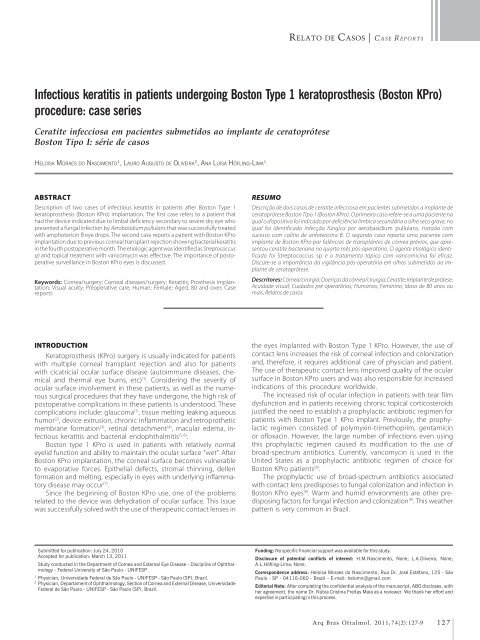a rquivos b rasileiros - Conselho Brasileiro de Oftalmologia
a rquivos b rasileiros - Conselho Brasileiro de Oftalmologia
a rquivos b rasileiros - Conselho Brasileiro de Oftalmologia
Create successful ePaper yourself
Turn your PDF publications into a flip-book with our unique Google optimized e-Paper software.
RELATO DE CASOS | CASE REPORTS<br />
Infectious keratitis in patients un<strong>de</strong>rgoing Boston Type 1 keratoprosthesis (Boston KPro)<br />
procedure: case series<br />
Ceratite infecciosa em pacientes submetidos ao implante <strong>de</strong> ceratoprótese<br />
Boston Tipo I: série <strong>de</strong> casos<br />
HELOISA MORAES DO NASCIMENTO 1 , LAURO AUGUSTO DE OLIVEIRA 2 , ANA LUISA HÖFLING-LIMA 1<br />
ABSTRACT<br />
Description of two cases of infectious keratitis in patients after Boston Type 1<br />
keratoprosthesis (Boston KPro) implantation. The first case refers to a patient that<br />
had the <strong>de</strong>vice indicated due to limbal <strong>de</strong>ficiency secondary to severe dry eye who<br />
presented a fungal infection by Aerobasidium pullulans that was successfully treated<br />
with amphotericin B eye drops. The second case reports a patient with Boston KPro<br />
implantation due to previous corneal transplant rejection showing bacterial keratitis<br />
in the fourth postoperative month. The etiologic agent was i<strong>de</strong>ntified as Streptococcus<br />
sp and topical treatment with vancomycin was effective. The importance of postoperative<br />
surveillance in Boston KPro eyes is discussed.<br />
Keywords: Cornea/surgery; Corneal diseases/surgery; Keratitis; Prosthesis implantation;<br />
Visual acuity; Preoperative care; Human; Female; Aged, 80 and over; Case<br />
reports<br />
RESUMO<br />
Descrição <strong>de</strong> dois casos <strong>de</strong> ceratite infecciosa em pacientes submetidos a implante <strong>de</strong><br />
ceratoprótese Boston Tipo 1 (Boston KPro). O primeiro caso refere-se a uma paciente na<br />
qual o dispositivo foi indicado por <strong>de</strong>ficiência límbica secundária a olho seco grave, no<br />
qual foi i<strong>de</strong>ntificado infecção fúngica por aerobasidium pullulans, tratada com<br />
sucesso com colírio <strong>de</strong> anfotericina B. O segundo caso reporta uma paciente com<br />
implante <strong>de</strong> Boston KPro por falências <strong>de</strong> transplantes <strong>de</strong> córnea prévios, que apresentou<br />
ceratite bacteriana no quarto mês pós-operatório. O agente etiológico i<strong>de</strong>ntificado<br />
foi Streptococcus sp e o tratamento tópico com vancomicina foi eficaz.<br />
Discute-se a importância da vigilância pós-operatória em olhos submetidos ao implante<br />
<strong>de</strong> ceratoprótese.<br />
Descritores: Córnea/cirurgia; Doenças da córnea/cirurgia; Ceratite; Implante <strong>de</strong> prótese;<br />
Acuida<strong>de</strong> visual; Cuidados pré operatórios; Humanos; Feminino; Idoso <strong>de</strong> 80 anos ou<br />
mais; Relatos <strong>de</strong> casos<br />
INTRODUCTION<br />
Keratoprosthesis (KPro) surgery is usually indicated for patients<br />
with multiple corneal transplant rejection and also for patients<br />
with cicatricial ocular surface disease (autoimmune diseases, chemical<br />
and thermal eye burns, etc) (1) . Consi<strong>de</strong>ring the severity of<br />
ocular surface involvement in these patients, as well as the numerous<br />
surgical procedures that they have un<strong>de</strong>rgone, the high risk of<br />
postoperative complications in these patients is un<strong>de</strong>rstood. These<br />
complications inclu<strong>de</strong>: glaucoma (1) , tissue melting leaking aqueous<br />
humor (2) , <strong>de</strong>vice extrusion, chronic inflammation and retroprothetic<br />
membrane formation (3) , retinal <strong>de</strong>tachment (4) , macular e<strong>de</strong>ma, infectious<br />
keratitis and bacterial endophthalmitis (5-6) .<br />
Boston type 1 KPro is used in patients with relatively normal<br />
eyelid function and ability to maintain the ocular surface “wet”. After<br />
Boston KPro implantation, the corneal surface becomes vulnerable<br />
to evaporative forces. Epithelial <strong>de</strong>fects, stromal thinning, <strong>de</strong>llen<br />
formation and melting, especially in eyes with un<strong>de</strong>rlying inflammatory<br />
disease may occur (7) .<br />
Since the beginning of Boston KPro use, one of the problems<br />
related to the <strong>de</strong>vice was <strong>de</strong>hydration of ocular surface. This issue<br />
was successfully solved with the use of therapeutic contact lenses in<br />
the eyes implanted with Boston Type 1 KPro. However, the use of<br />
contact lens increases the risk of corneal infection and colonization<br />
and, therefore, it requires additional care of physician and patient.<br />
The use of therapeutic contact lens improved quality of the ocular<br />
surface in Boston KPro users and was also responsible for increased<br />
indications of this procedure worldwi<strong>de</strong>.<br />
The increased risk of ocular infection in patients with tear film<br />
dysfunction and in patients receiving chronic topical corticosteroids<br />
justified the need to establish a prophylactic antibiotic regimen for<br />
patients with Boston Type 1 KPro implant. Previously, the prophylactic<br />
regimen consisted of polymyxin-trimethoprim, gentamicin<br />
or ofloxacin. However, the large number of infections even using<br />
this prophylactic regimen caused its modification to the use of<br />
broad-spectrum antibiotics. Currently, vancomycin is used in the<br />
United States as a prophylactic antibiotic regimen of choice for<br />
Boston KPro patients (8) .<br />
The prophylactic use of broad-spectrum antibiotics associated<br />
with contact lens predisposes to fungal colonization and infection in<br />
Boston KPro eyes (9) . Warm and humid environments are other predisposing<br />
factors for fungal infection and colonization (9) . This weather<br />
pattern is very common in Brazil.<br />
Submitted for publication: July 24, 2010<br />
Accepted for publication: March 13, 2011<br />
Study conducted in the Department of Cornea and External Eye Disease - Discipline of Ophthalmology<br />
- Fe<strong>de</strong>ral University of São Paulo - UNIFESP.<br />
1<br />
Physician, Universida<strong>de</strong> Fe<strong>de</strong>ral <strong>de</strong> São Paulo - UNIFESP - São Paulo (SP), Brazil.<br />
2<br />
Physician, Departament of Ophthalmology, Section of Cornea and External Disease, Universida<strong>de</strong><br />
Fe<strong>de</strong>ral <strong>de</strong> São Paulo - UNIFESP - São Paulo (SP), Brazil.<br />
Funding: No specific financial support was available for this study.<br />
Disclosure of potential conflicts of interest: H.M.Nascimento, None; L.A.Oliveira, None;<br />
A.L.Höfling-Lima, None.<br />
Correspon<strong>de</strong>nce address: Heloisa Moraes do Nascimento, Rua Dr. José Estéfano, 125 - São<br />
Paulo - SP - 04116-060 - Brazil - E-mail: helomn@gmail.com<br />
Editorial Note: After completing the confi<strong>de</strong>ntial analysis of the manuscript, ABO discloses, with<br />
her agreement, the name Dr. Núbia Cristina Freitas Maia as a reviewer. We thank her effort and<br />
expertise in participating in this process.<br />
Arq Bras Oftalmol. 2011;74(2):127-9<br />
127

















